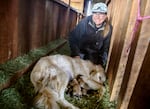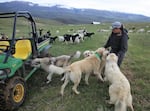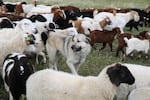For the last few weeks, rancher Kim Kerns has been living in a 1970s trailer, up on a high meadow, with 550 sheep as they fatten up on spring grass.
Her family has used livestock protection dogs up here since the 1980s when she first got a Maremma guard dog from the U.S. Department of Agriculture.
But that was before wolves returned.
“We’ve actually kind of changed the type and size of dog we use,” she said. “We’re using a bigger and more aggressive guard dog now than we did in the ‘80s and even the ‘90s.”
Now her dogs are a mix of Akbash, Kangal and Anatolian, three massive, ancient breeds out of Turkey. All of them can be 100 pounds or more and have a bite pressure of 740 pounds per square inch. Statistics vary, but a wolf’s bite force is between 400 psi and 1,500 psi.
Kerns runs eight guard dogs at a cost of $500 a month in feed. But she said the animals pay their ways by reducing the labor of controlling sheep and reducing predator kills.

Kim Kerns moves the mobile electric fence she uses to protect her sheep from wolves at night.
Kristian Foden-Vencil / OPB
Over the last couple of decades, Oregon and much of the West has been conducting an enormous ecological experiment by allowing wolves to once more roam the landscape.
For ranchers, wolves are another predator to guard against. But unlike coyotes, bears, bobcats or mountain lions, wolves hunt in packs and can be very persistent. They’re also smart. So they learn quickly that a sound cannon, a bunch of flags, or even gunfire into the air aren’t a real danger. And they return.
Kerns remembers a two-week period last year when wolves were picking off her sheep, one-by-one. Even her dogs weren’t a match.
“We weren’t getting any sleep, the guard dogs weren’t getting any sleep, everybody was run ragged,” she said. “And it was terrifying. Like it was flat scary.”
She tried everything, from spotlights and electrical fences at night, but the wolves kept coming.
“Finally we just decided that we couldn’t take it anymore. We moved the sheep a couple of miles,” she said. “It seemed to be outside of where the wolves were.”

Rancher Kim Kerns sits in the trailer she uses when looking after her sheep up in the hills.
Kristian Foden-Vencil / OPB
Now Kerns relies on the dogs to alert her to wolves. They can smell or see a wolf well before she can, and they start to bark and get agitated.
Kerns surrounds her sheep with a sturdy electric fence at night or moves them to another pasture. She is permitted to shoot a wolf if it’s actively attacking. But since they’re federally protected, she needs really good proof. Also, shooting a wolf in a herd would just as likely result in the death of a sheep.
The Oregon Department of Agriculture has a compensation program to reimburse ranchers. But Kerns said it pays little and the loss of just one ewe can cause real damage, even though it might only fetch $200 at market.
“There are some 5- or 6-year-old ewes in there that know every single camp we go to. Every single waterhole,” Kerns said. “That ewe is really irreplaceable in my flock.”
Kerns thinks the compensation program just gives the public permission to turn a blind eye to the problem.
Unlike many ranchers, Kerns doesn’t want to see wolves eliminated again. But she’d like a quicker response from the government when she sends in a kill request.

Rancher Shirley Shold breeds Akbash Kangal dogs for ranchers who want bigger livestock protection animals, now that wolves are in Eastern Oregon.
Kristian Foden-Vencil / OPB
Another rancher in the Baker City area, Shirley Shold, agrees: “I think it would be better for everyone, and the packs, if they were spread out more.”
She started breeding dogs that are suitable for herds after finding freshly killed calves and lambs.
“Seeing the loss of a newborn life was very hard,” said Shold, who moved from Portland 12 years ago.
“So I started thinking, we’ve got to do something different. And I was talking to a fellow rancher and she said, ‘If you’ve got wolves, you want Kangal dogs.’”
So Shold got a Kangal and Akbash pair and now breeds them for other ranchers at about $800 a head.
How good the dogs turn out to be depends largely on their nature, said Shold. Some dogs are more nurturing and remain in the middle of their herds. While other dogs become perimeter dogs, scouting outside the herd for predators.

Shirley Shold greets her livestock protection dogs out on her ranch just east of Baker City.
Kristian Foden-Vencil / OPB
Watching them is like watching a sheep dog trial. Except that instead of a human issuing orders, these dogs follow their inner natures.
But many traditional ranchers aren’t convinced the dogs can keep wolves away and they point out, the dogs are expensive to feed.
But Shold thinks attitudes are changing as more wolves appear and ranchers see others in the business using large dogs to protect their livestock.
Shold’s ranch can be seen from the road.
“Everybody started paying attention,” she said. “People really started … watching the dogs because they can observe them from the highway, and I know it’s making an impact. They’re seeing that this can help.”

Livestock protection dogs have different characters. Some like to do their jobs from the middle of the herd. Others prefer to roam outside the heard in search of predators.
Kristian Foden-Vencil / OPB
The dogs’ ability to manage a sheep herd is well recognized. But Shold wants to integrate them into cattle herds as well.
Others aren’t so sure. They point out that cows don’t herd together like sheep. That means the dogs have to patrol much larger areas. But on Shold’s ranch, the cattle do seem tolerant of the dogs.

Brian Ratliff, with the Oregon Department of Fish and Wildlife, said some ranchers are seeing success with the large dog breeds.
Kristian Foden-Vencil / OPB
Brian Ratliff, with the Oregon Department of Fish and Wildlife, said some ranchers are seeing success with the large dog breeds.
“Livestock protection dogs will work or have some noticeable benefits on certain operations. So, sheep and goats. Also in confined areas, smaller pastures, with cattle,” he said.
But it’s not about having the dogs fight the wolves.
“The most important thing I think that livestock protection dogs do … is they alert the producer to what’s going on,” he said.
Back on the slopes of Kim Kerns’ ranch, she watches her dogs move the herd to greener pastures. She said yes, the dogs are useful: ”They’re another tool in the tool box.”
But they’re not a silver bullet.

One of Kim Kerns' favorite livestock protection dogs, Opal, places herself firmly between the photographer and the herd.
Kristian Foden-Vencil / OPB

